Study of the Dynamic Recrystallization Process of the Inconel625 Alloy at a High Strain Rate
Abstract
:1. Introduction
2. Materials and Experimental Methods
3. Results
3.1. The True Stress–Strain Curves and Constitutive Model
3.2. The Dynamic Recrystallization Behavior of the Inconel625 Alloy
3.3. The Texture Evolution of the Inconel625 Alloy
3.4. Discussion
4. Conclusions
- The true stress–true strain curves exhibited a clear steady state flow rule at different temperatures and different strain rates. The adiabatic heating effect decreased with decreasing temperature and increasing strain rate.
- The dynamic recrystallization process with increasing temperature was accompanied by an increase in twinning boundaries and a consumption of the subgrains, while the change of subgrains and twinnings was opposite for the grain growth after the completion of dynamic recrystallization at 1200 °C. There were almost no low-angle grain boundaries at 1100 °C, which indicated that complete dynamic recrystallization had occurred.
- At a high strain rate, the continuous dynamic recrystallization with subgrain amalgamation and rotation of the Inconel625 alloy played a significant role, whereas the discontinuous dynamic recrystallization, with a bulging boundary induced by twinning, played an auxiliary role.
- At a high strain rate, the texture was weakly correlated with the change in temperature. The crystal orientation was random after temperature increase, and the Inconel625 alloy showed no obvious texture.
- The subgrain played a significant role during the DRX process. The nucleation of subgrain and DRX was dependent on the motion of the dislocations during the hot deformation.
Author Contributions
Funding
Conflicts of Interest
References
- Chen, X.M.; Lin, Y.C.; Chen, M.S.; Li, H.B.; Wen, D.X.; Zhang, J.L.; He, M. Microstructural Evolution of a Nickel-based Superalloy during Hot Deformation. Mater. Des. 2015, 77, 41–47. [Google Scholar] [CrossRef]
- Zuo, F.; Liu, L.; Wang, C.; Chen, F.; Zhang, Z.H. Prediction of Hot Deformation Behavior in Ni-based Alloy Considering the Effect of Initial Microstructure. Prog. Nat. Sci. Mater. Int. 2015, 25, 66–77. [Google Scholar] [CrossRef]
- Shi, Z.; Yan, X.; Duan, C.; Tang, C.; Pu, E. Characterization of the Hot Deformation Behavior of a Newly Developed Nickel- Based Superalloy. J. Mater. Eng. Perform. 2018, 27, 1763–1776. [Google Scholar] [CrossRef]
- Lin, Y.C.; Wu, X.Y.; Chen, X.M.; Chen, J.; Wen, D.X.; Zhang, J.L.; Li, L.T. EBSD Study of a Hot Deformed Nickel-based superalloy. J. Alloys Compd. 2015, 640, 101–113. [Google Scholar] [CrossRef]
- Cheng, L.; Xue, X.Y.; Tang, B.; Liu, D.G.; Li, J.Z.; Kou, H.C.; Li, J.S. Deformation Behavior of Hot-rolled IN718 Superalloy under Plane Strain Compression at Elevated Temperature. Mater. Sci. Eng. A 2014, 606, 24–30. [Google Scholar] [CrossRef]
- Lin, Y.C.; Li, J.; Chen, M.; Liu, Y.; Liang, Y. A deep Belief Network to Predict the Hot Deformation Behavior of a Ni-based Superalloy. Neural Comput. Appl. 2018, 27, 1015–1023. [Google Scholar]
- You, X.; Tan, Y.; Wu, C.; You, Q.; Zhao, L.; Li, J. The Precipitation Behavior and Hot Deformation Characteristics of Electron Beam Smelted Inconel 740 Superalloy. J. Mater. Eng. Perform. 2018, 745, 33–43. [Google Scholar] [CrossRef]
- Lissarrague; Sosa, M.; Fernando, P.; Alberto, P.; Silvina, L. Hot Deformation Characteristics and Hot Working Window of as-cast Large-tonnage GH3535 Superalloy Ingot. J. Mater. Sci. Technol. 2018, 34, 2437–2446. [Google Scholar]
- Hu, Y.; Liu, D.; Zhu, X.; Yang, Y.; Wang, J.; Wang, H. Effect of Rolling Passes on Thermal Parameters and Microstructure Evolution via Ring-rolling Process of GH4738 Superalloy. Int. J. Adv. Manuf. Tech. 2018, 76, 1165–1174. [Google Scholar] [CrossRef]
- Jun, L.; Li, J.; Ghosh, F.S.; Li, P.; Wang, J.; Chen, W.; Wang, Z.; Tang, T.; Ramasse, W. Quentin Schumacher, Peter. Correlative characterization on Microstructure Evolution of Ni-based K403 Alloy during Thermal Exposure. Acta Mater. 2017, 131, 167–186. [Google Scholar]
- Lia, J.; Zhao, Z.; Bai, P.; Qu, H.; Liu, B.; Li, L.; Wu, L.; Guan, R.; Liu, H.; Guo, Z. Microstructural Evolution and Mechanical Properties of IN718 alloy Fabricated by Selective Laser Melting Following Different Heat Treatments. J. Alloy Compd. 2017, 772, 861–870. [Google Scholar] [CrossRef]
- Strößner, J.; Terock, M.; Glatzel, U. Mechanical and Microstructural Investigation of Nickel-based Superalloy IN718 Manufactured by Selective Laser Melting (SLM). Adv. Eng. Mater. 2015, 17, 177–1105. [Google Scholar] [CrossRef]
- Wang, Z.; Guan, K.; Gao, M. The Microstructure and Mechanical Properties of Deposited-IN718 by Selective Laser Melting. J. Alloys Compd. 2012, 513, 518–523. [Google Scholar] [CrossRef]
- Wen, D.X.; Lin, Y.C.; Chen, J.; Chen, X.M.; Zhang, J.L.; Liang, Y.J.; Li, L.T. Work-hardening Behaviors of Typical Solution-treated and Aged Nickel-based Superalloy During Hot Deformation. J. Alloys Compd. 2015, 618, 372–377. [Google Scholar] [CrossRef]
- Ning, Y.Q.; Wang, T.; Fu, M.W.; Li, M.Z.; Wang, L.; Zhao, C.D. Competition Between Work-hardening Effect and Dynamic-softening Behavior for Processing as-cast GH4720Li Superalloys with Original Dendrite Microstructure during Moderate-speed Hot Compression. Mat. Sci. Eng. A 2015, 642, 187–193. [Google Scholar] [CrossRef]
- Hussain, M.Z.; Li, F.G.; Wang, J.; Yuan, Z.W.; Li, P.; Wu, T. Determination of Constitutive Equation for Thermo-mechanical Processing of INCONEL 718 Through Double Multivariate Nonlinear Regression ANALYSIS. J. Mater. Eng. Perform. 2015, 24, 1–13. [Google Scholar] [CrossRef]
- Lin, Y.C.; He, M.; Zhou, M.; Xu, D.; Chen, W. New Constitutive Model for Hot Deformation Behaviors of Ni-Based Superalloy Considering the Effects of Initial δ Phase. J. Mater. Eng. Perform. 2015, 24, 3527–3538. [Google Scholar] [CrossRef]
- Lin, Y.C.; Li, K.; Chen, H.; Chen, J.; Wen, X.; Dong, X. New Constitutive Model for High-temperature Deformation Behavior of Inconel718 Superalloy. Mater. Design. 2015, 74, 108–118. [Google Scholar] [CrossRef]
- Liu, Y.; Ning, Y.; Yao, Z.; Guo, H.; Nan, Y. Effect of True Strains on Processing Map for Isothermal Compression of Ni–20.0Cr–2.5Ti–1.5Nb–1.0Al Ni-base superalloy. J. Alloys Compd. 2014, 612, 56–63. [Google Scholar] [CrossRef]
- Wang, Y.; Pan, Q.L.; Song, Y.F.; Li, C.; Li, Z.F. Hot Deformation and Processing Maps of X-750 Nickel-based Superalloy. Mater. Des. 2013, 51, 154–160. [Google Scholar] [CrossRef]
- He, G.A.; Liu, F.; Si, J.Y.; Yang, C.; Jiang, L. Characterization of Hot Compression Behavior of a New HIPed Nickel-based P/M Superalloy using Processing Maps. Mater. Des. 2015, 87, 256–265. [Google Scholar] [CrossRef]
- Wu, Y.; Liu, Y.; Li, C.; Xing, C.; Li, Y.; Wang, H.; Peng, H. Deformation Behavior and Processing Maps of Ni3Al-based Superalloy During Isothermal Hot Compression. J. Alloys Compd. 2017, 712, 687–695. [Google Scholar] [CrossRef]
- Chen, M.; Lin, Y.C.; Li, K.; Chen, J. The Nonlinear Unloading Behavior of a Typical Ni-based Superalloy during Hot Deformation: A New Elasto-viscoplastic Constitutive Model. Appl. Phys. A 2016, 122, 854. [Google Scholar] [CrossRef]
- Wang, M.; Wang, W.; Liu, Z.; Sun, C.; Qian, L. Hot Workability Integrating Processing and Activation Energy Maps of Inconel 740 Superalloy. Mater. Today Com. 2018, 14, 188–198. [Google Scholar] [CrossRef]
- Shi, Z.; Duan, X.; Song, C.; Zhao, J.; Wang, M. Hot Deformation Behavior of GH4745 Superalloy using Constitutive Equation and Processing map. J Iron. Steel Res. Int. 2017, 24, 625–633. [Google Scholar] [CrossRef]
- Luo, Y.X.; Heng, Y.Q.; Wang, Y.Q.; Yan, X.C. Dynamic Recrystallization Behavior of TA15 Titanium Alloy under Isothermal Compression during Hot Deformation. Mater. Sci. Eng. 2014, 41, 31–43. [Google Scholar] [CrossRef]
- Jiang, H.; Dong, J.X.; Zhang, M.C.; Yao, Z.H. Analysis of Twinnings and Substructures during Low Strain rate hot Deformation and Contribution to Dynamic Recrystallization in Alloy 617B. Mater. Sci. Eng. A 2016, 647, 367–381. [Google Scholar]
- Pradhan, S.K.; Mandal, S.; Athreya, C.N.; Babu, K. Arun de Boer, B. Sarma, V. Influence of Processing Parameters on Dynamic Recrystallization and the Associated Annealing Twin Boundary Analysis in a Nickel base Superalloy. Mater. Sci. Eng. A 2017, 700, 47–58. [Google Scholar] [CrossRef]
- Li, F.; Yin, R.; Feng, F.; Wang, D.; Du, H.; Yong, G. Impact of γ′(Ni3(Al,Ti)) Phase on Dynamic Recrystallization of a Ni-based Disk Superalloy during Isothermal Compression. J Alloys Compd. 2017, 673, 1076–1082. [Google Scholar] [CrossRef]
- He, G.A.; Liu, F.; Lan, H.; Wang, J. Microstructure Evolution and Nucleation Mechanisms of Dynamic Recrystallization of a Powder Metallurgy Ni-based Superalloy during Hot Compression. Mater. Sci. Eng. A 2016, 677, 476–504. [Google Scholar] [CrossRef]
- Saleh, A.A.; Parvez, M.; Tomé, C.N.; Pereloma, E.V. On the Analysis and Modelling of Cube Texture during Dynamic Recrystallisation of Ni–30Fe–Nb–C Model Alloy. J. Alloys Compd. 2018, 748, 620–636. [Google Scholar] [CrossRef]
- Guria, A.; Mandal, G.K.; Hodgson, P.; Beynon, J.H.; Chowdhury, S.G. Effect of Twinning on Microstructural Evolution during Dynamic Recrystallisation of Hot Deformed As-cast Austenitic Stainless Steel. Metall. Mater. Trans. A 2015, 46, 4423–4428. [Google Scholar] [CrossRef]
- Takaki, T.; Yoshimoto, C.; Yamanaka, A.; Tomita, Y. Multiscale Modeling of Hot-working with Dynamic Recrystallization by Coupling Microstructure Evolution and Macroscopic Mechanical Behavior. Int. J. Plast. 2014, 52, 105–116. [Google Scholar] [CrossRef]
- Zhang, C.; Zhang, L.; Shen, W.; Xu, Q.; Cui, Y. The Processing Map and Microstructure Evolution of Ni-Cr-Mo-based C276 Superalloy during Hot Compression. J. Alloys Compd. 2017, 728, 1269–1278. [Google Scholar] [CrossRef]
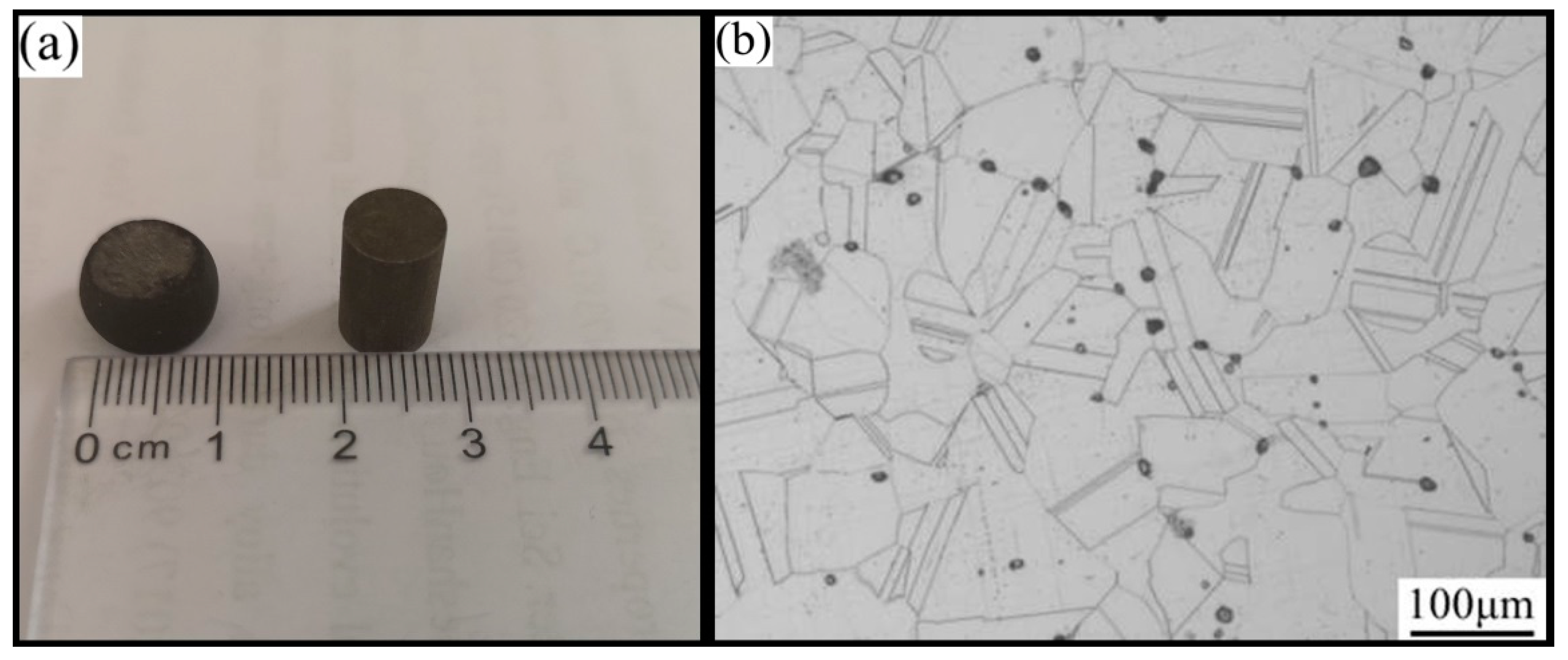
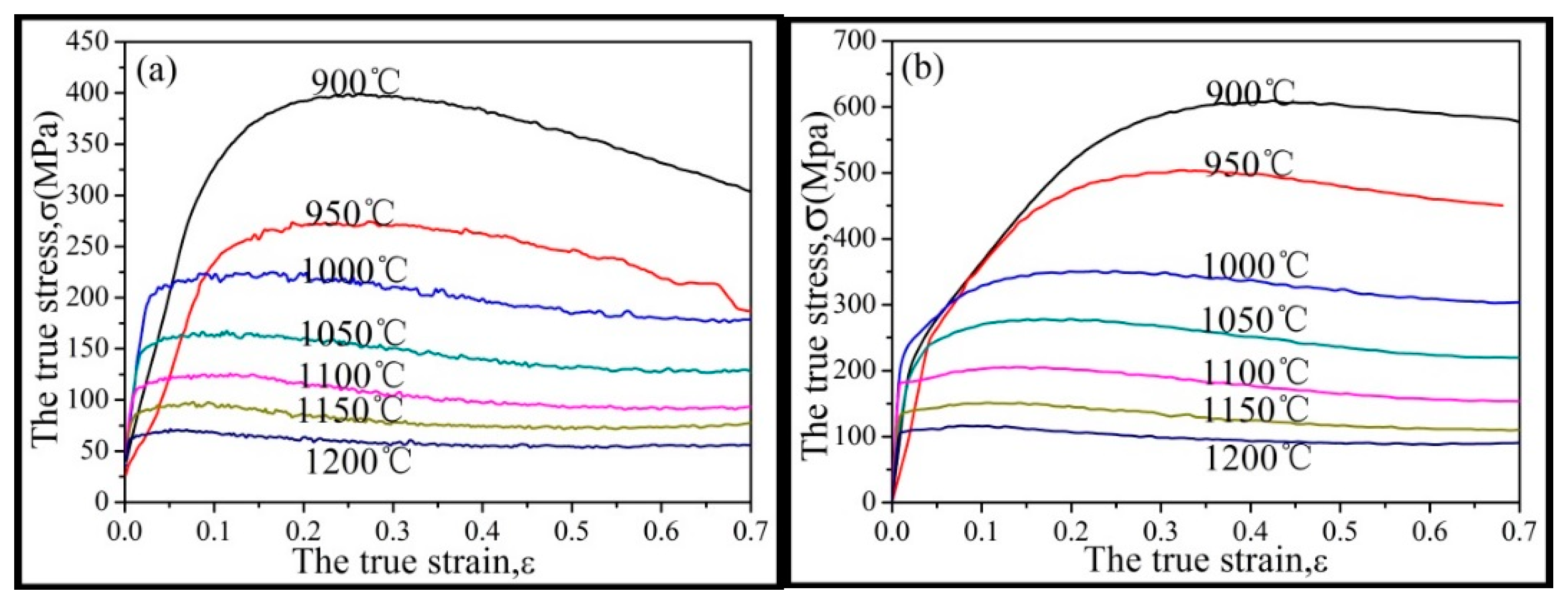
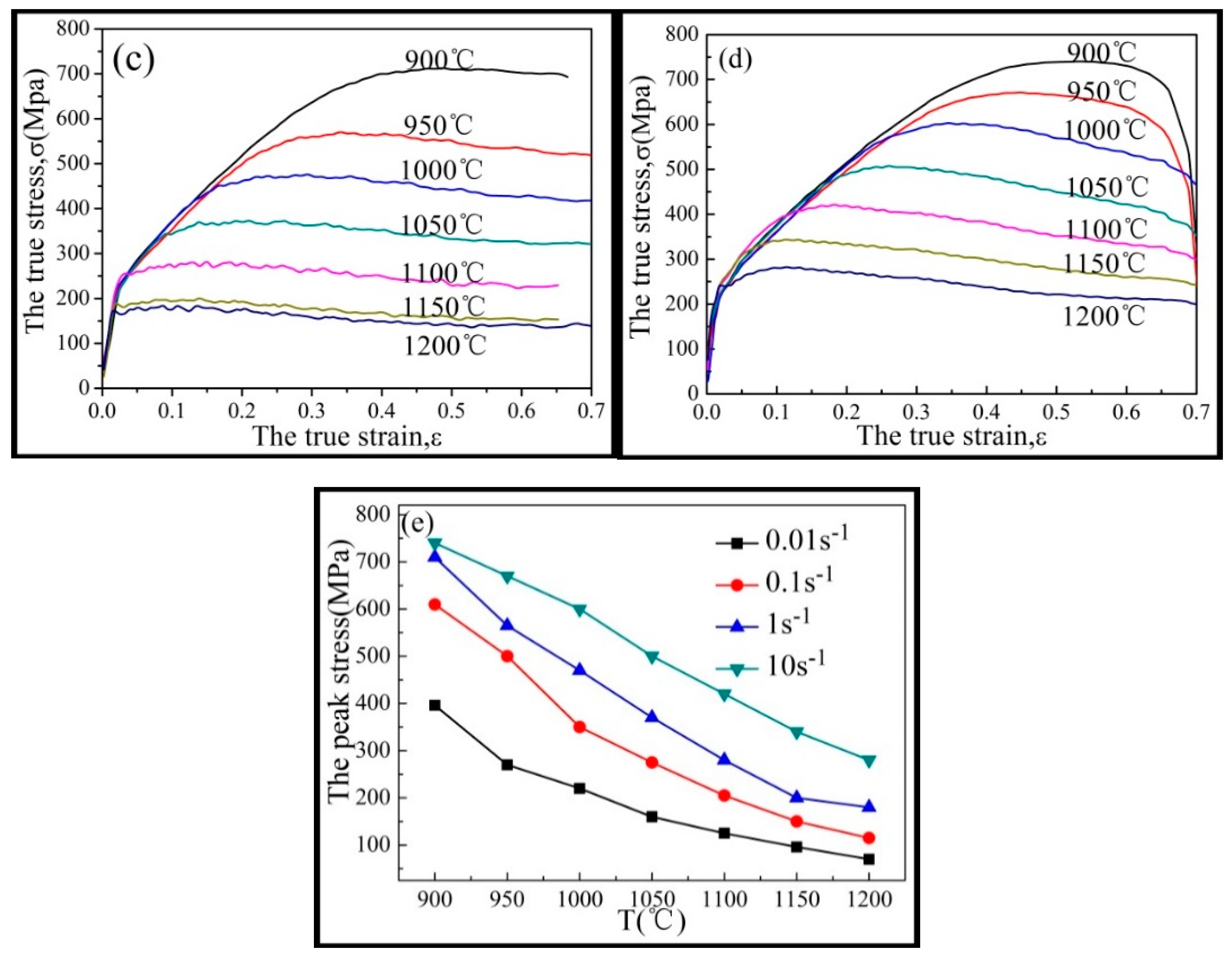

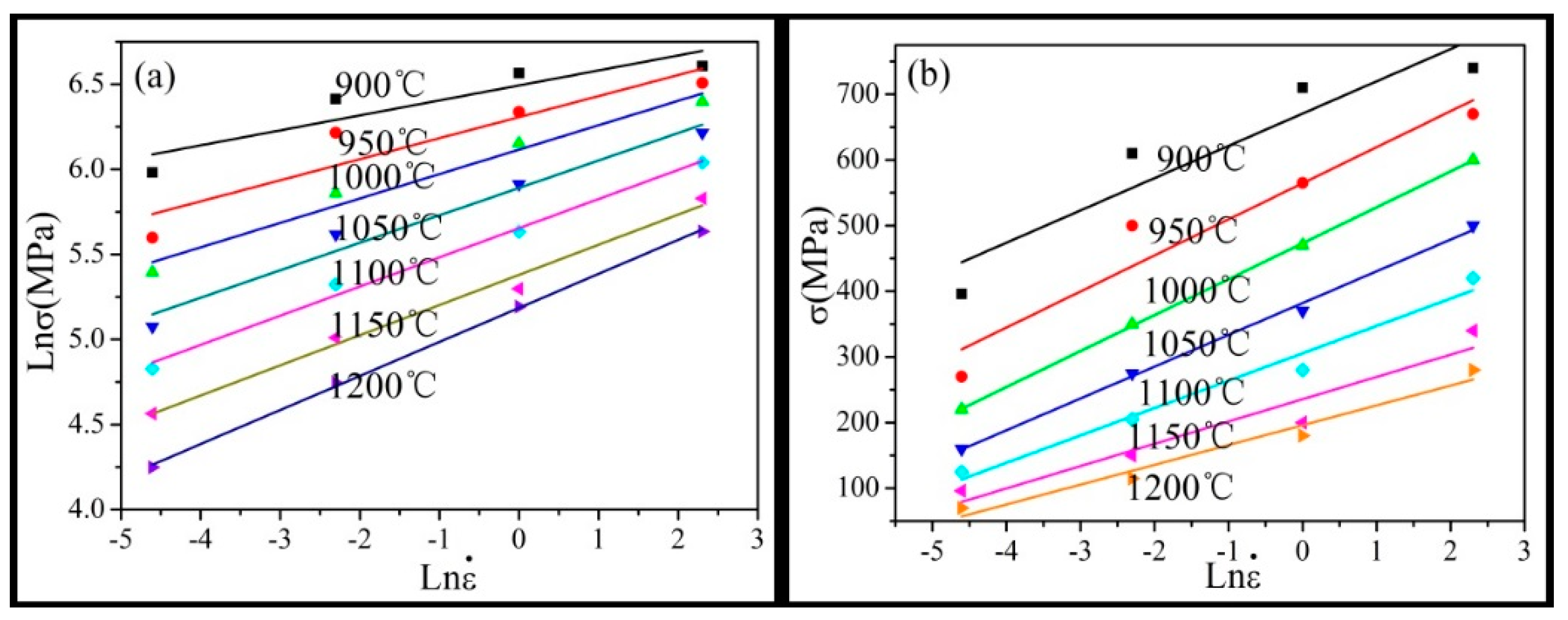
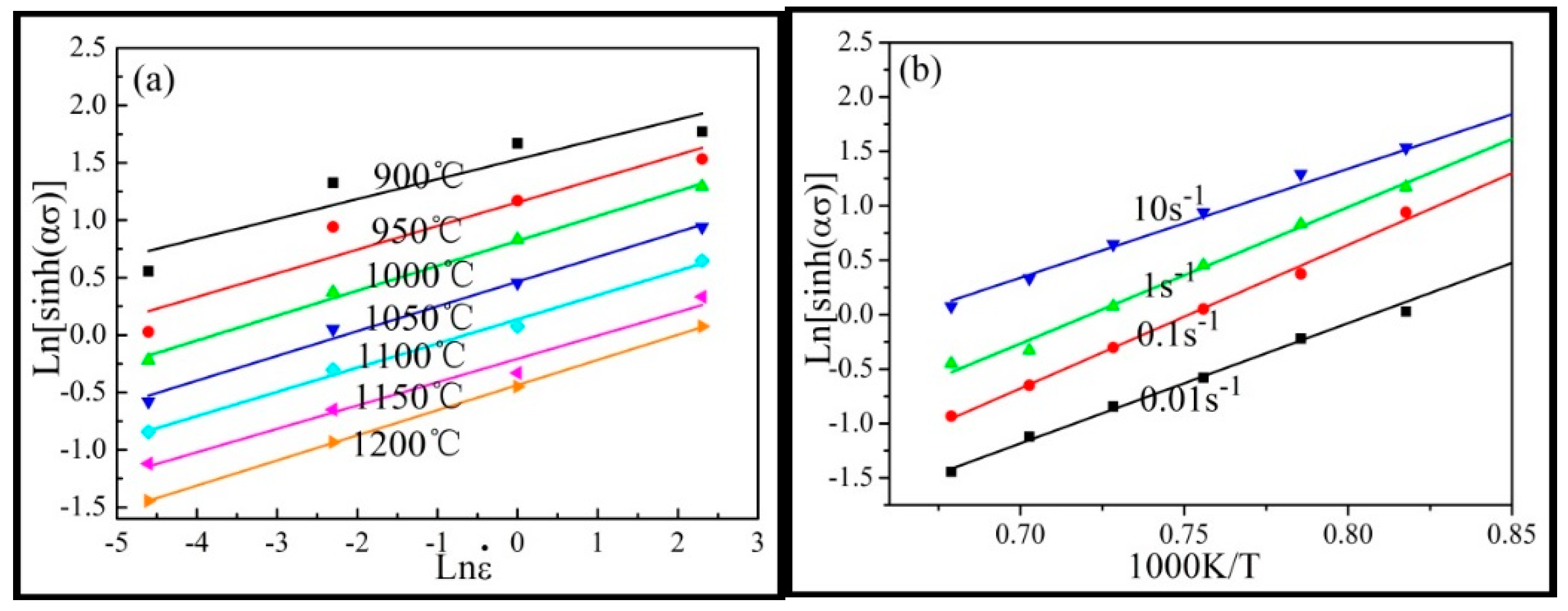
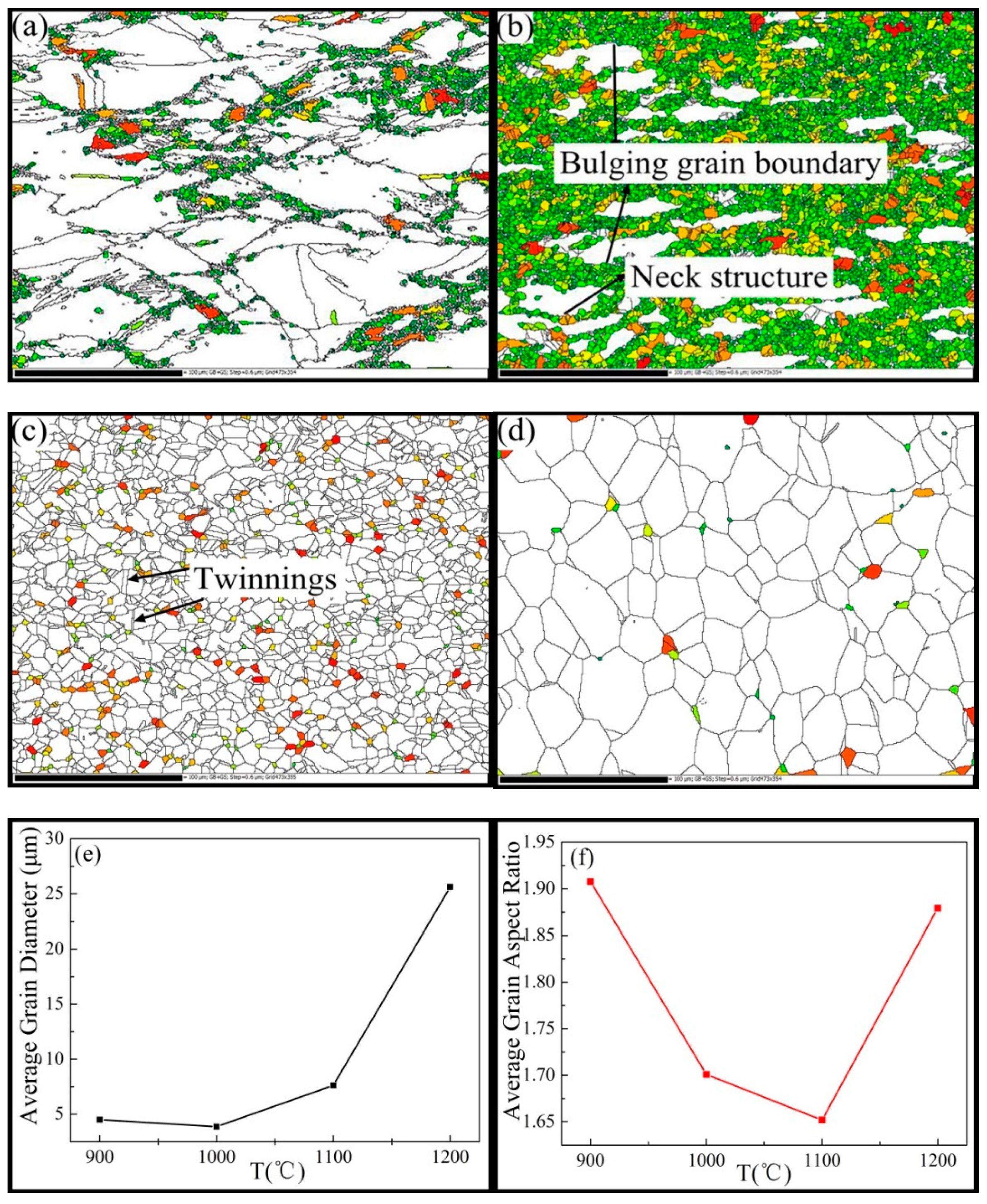


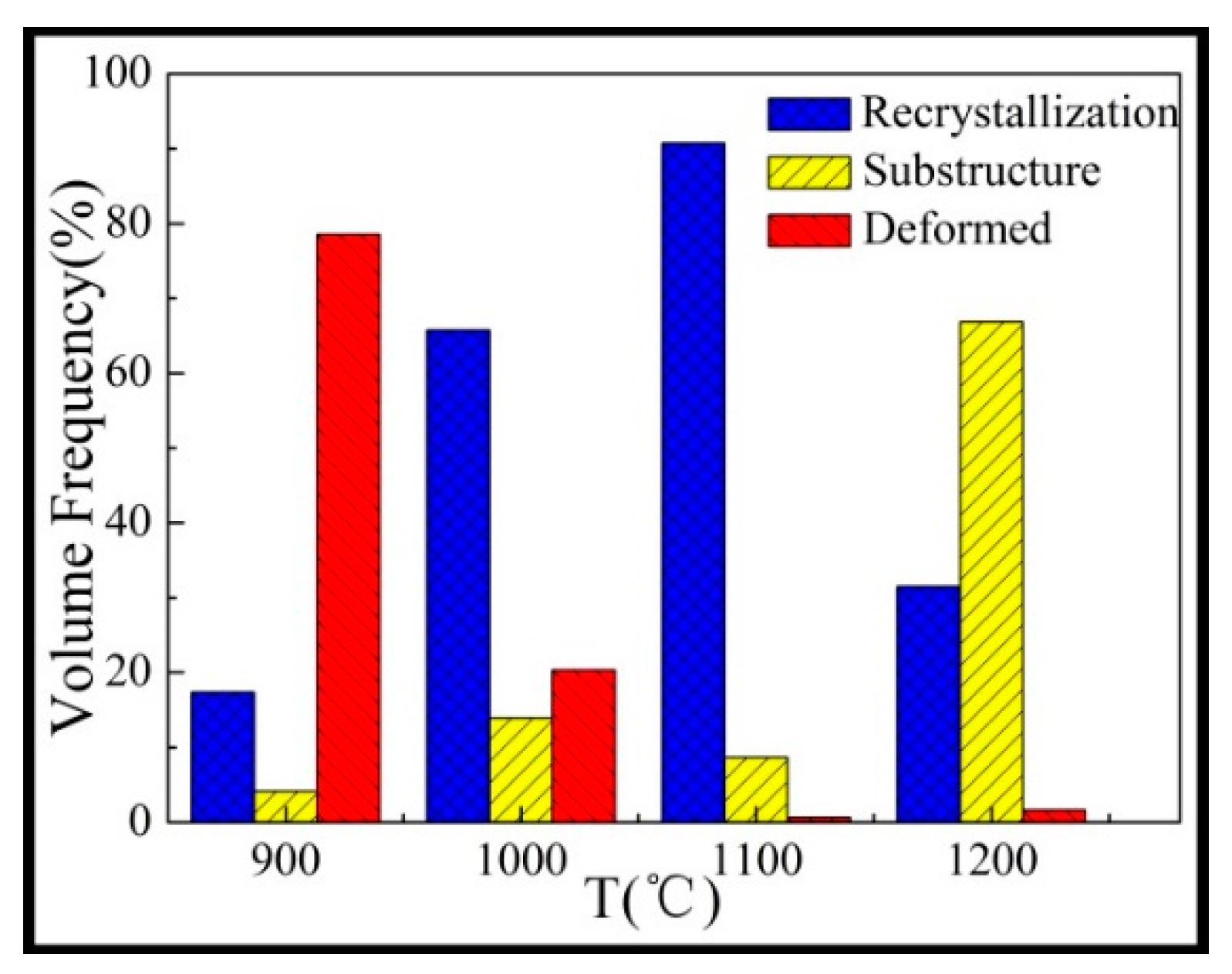
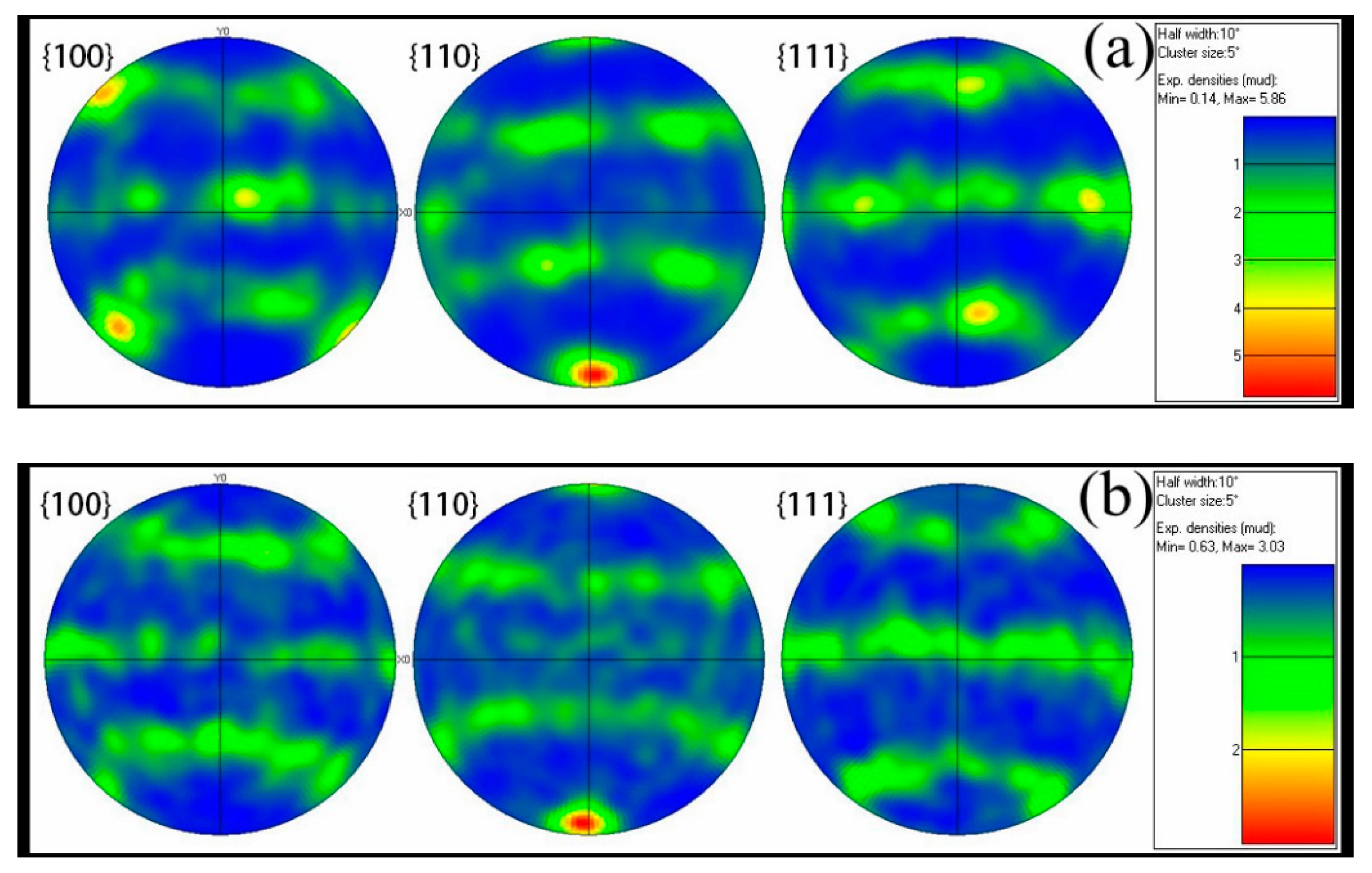
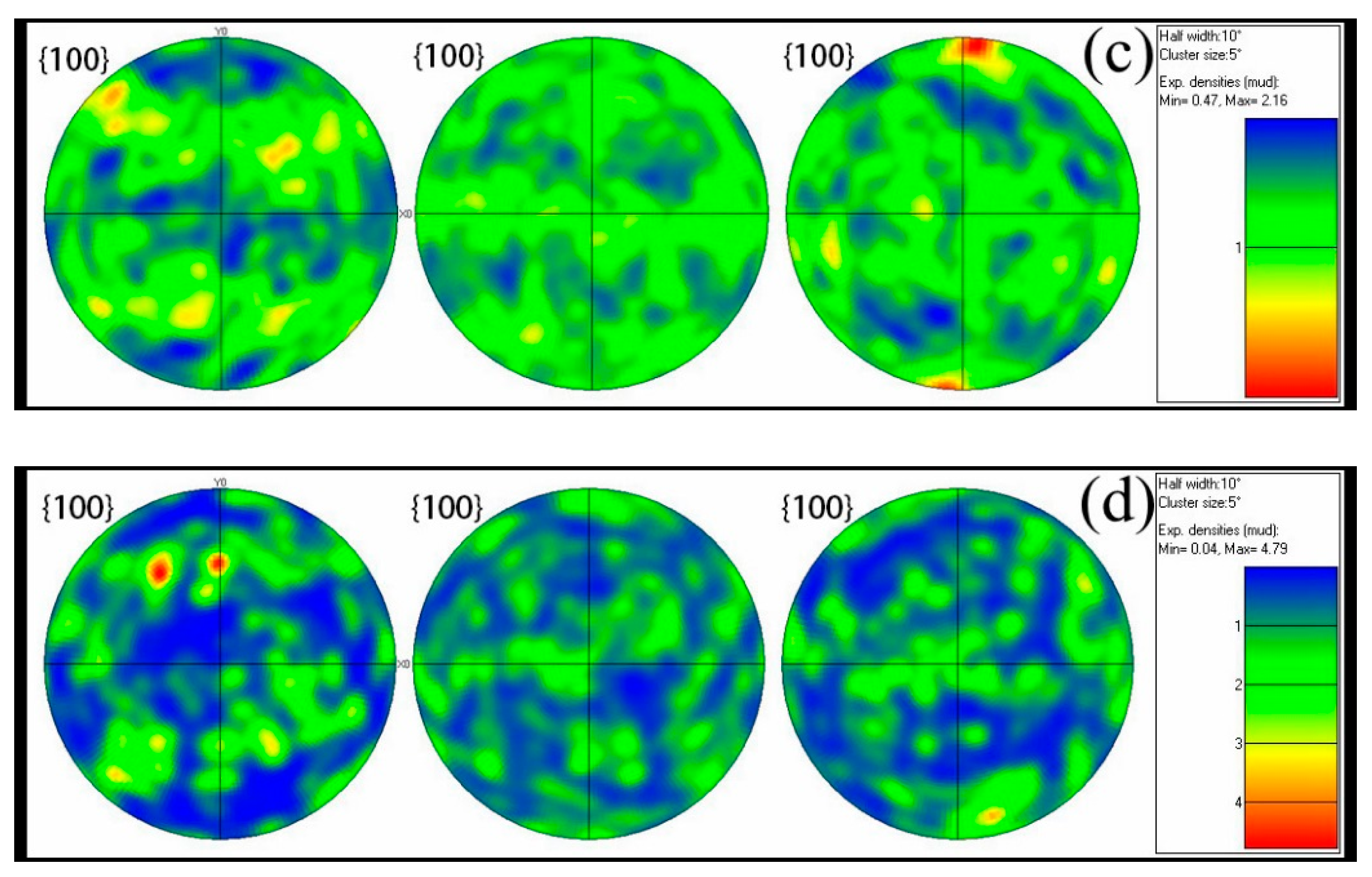
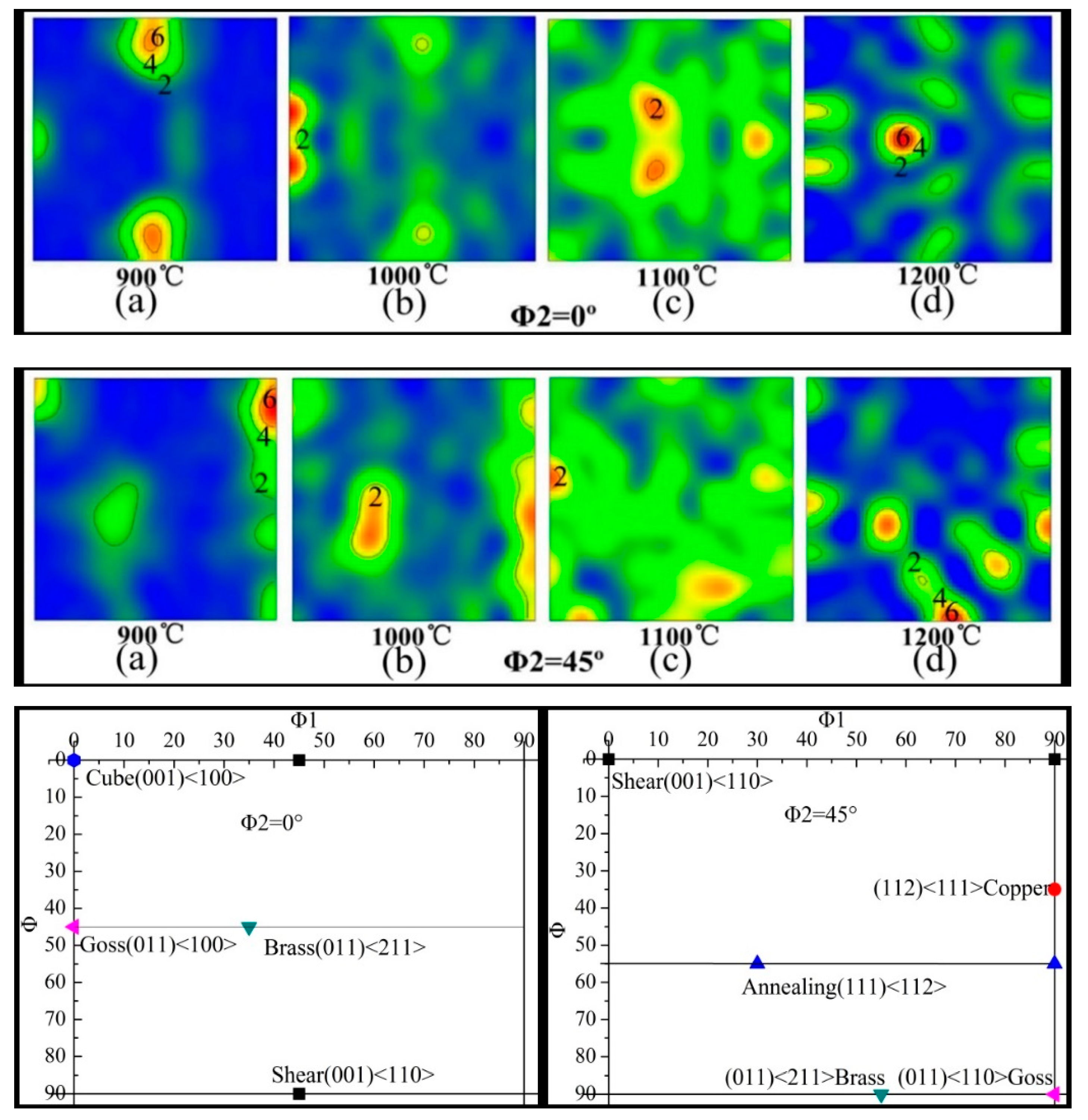
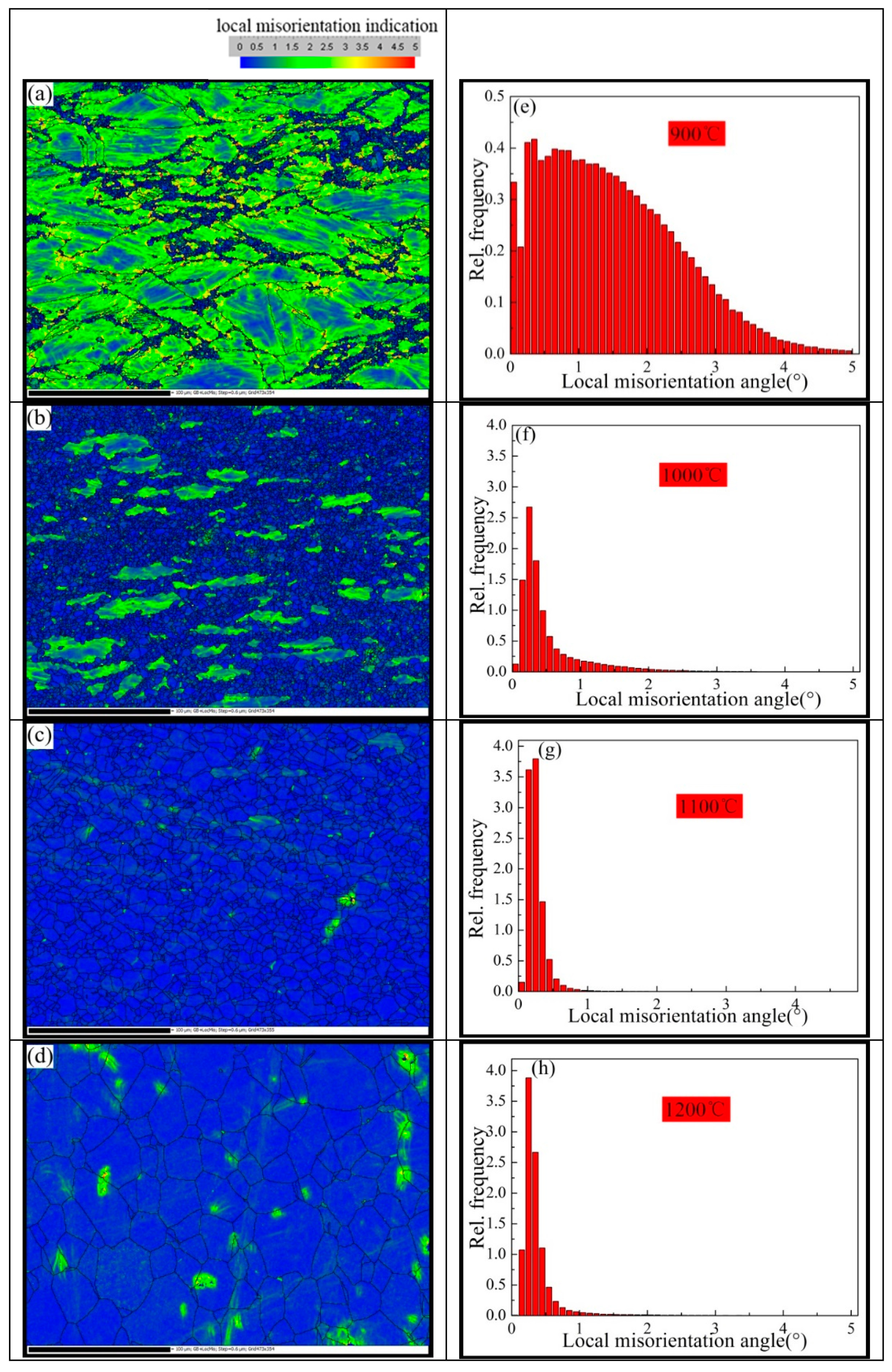

| C | Cr | Ni | Co | Mo | Al | Fe | Ti | Nb | Si | Mn |
|---|---|---|---|---|---|---|---|---|---|---|
| 0.042 | 21.77 | 60.63 | 0.19 | 8.79 | 0.21 | 3.68 | 0.40 | 3.75 | 0.12 | 0.2 |
| Condition/°C | Cube | Goss | Annealing | Brass | S | Copper | Shear | Random | Total Recrystallization Texture |
|---|---|---|---|---|---|---|---|---|---|
| 900 | 0.429 | 4.01 | 8.37 | 0.977 | 5.9 | 9.95 | 10.5 | 57.862 | 12.809 |
| 1000 | 1.6 | 4.42 | 7.98 | 3.65 | 6.78 | 6.02 | 3.56 | 65.99 | 14 |
| 1100 | 2.05 | 1.66 | 4.45 | 6.03 | 9.73 | 3.93 | 1.71 | 70.44 | 8.16 |
| 1200 | 0.427 | 3.26 | 2.72 | 10.6 | 12.5 | 1.81 | 5.24 | 63.623 | 6.407 |
© 2019 by the authors. Licensee MDPI, Basel, Switzerland. This article is an open access article distributed under the terms and conditions of the Creative Commons Attribution (CC BY) license (http://creativecommons.org/licenses/by/4.0/).
Share and Cite
Jia, Z.; Gao, Z.; Ji, J.; Liu, D.; Guo, T.; Ding, Y. Study of the Dynamic Recrystallization Process of the Inconel625 Alloy at a High Strain Rate. Materials 2019, 12, 510. https://doi.org/10.3390/ma12030510
Jia Z, Gao Z, Ji J, Liu D, Guo T, Ding Y. Study of the Dynamic Recrystallization Process of the Inconel625 Alloy at a High Strain Rate. Materials. 2019; 12(3):510. https://doi.org/10.3390/ma12030510
Chicago/Turabian StyleJia, Zhi, Zexi Gao, Jinjin Ji, Dexue Liu, Tingbiao Guo, and Yutian Ding. 2019. "Study of the Dynamic Recrystallization Process of the Inconel625 Alloy at a High Strain Rate" Materials 12, no. 3: 510. https://doi.org/10.3390/ma12030510




